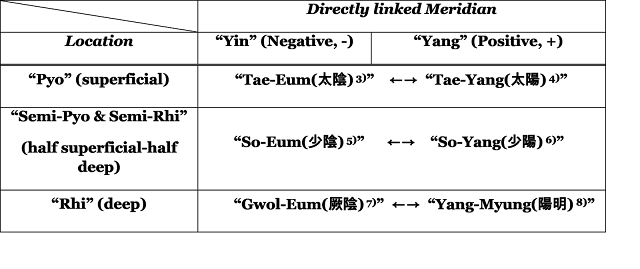Operating mechanism of the meridian system 7: The principle of “Jang-Bu Sang-Tong”
There are
many kinds of circulation in the meridian routes as follows:
Ø the “12-meridian circulation”
known as “Yung-Ki(營氣) circulation” or “Pyo-Rhi(表裏: relation of deep & superficial location) circulation”
Ø “Wi-Ki(衛氣) circulation” managed by Lung
Ø “8-Extraordinary Meridians”
including Conception Vessel (CV; 任脈, Im-Maek, Sea of Yin), Governor Vessel(GV; 督脈, Dok-Maek, Sea of Yang)
Ø Wiji-Daerak (胃之大絡; STGB - Stomach Centered Great
Branch Meridian), which runs through Stomach, Liver and Kidney
Ø Biji-Daerak (脾之大絡; SPGB - Spleen Centered Great Branch
Meridian), which runs through Spleen, Heart and Lung
Ø Other meridian routes which are
not yet known in the traditional Korean or other oriental medicine books
In fact,
only 40% of the meridian system has been known to mankind, while the other rest
has not been disclosed so far. Now it is the time to reinterpret the traditional
theory of meridian system, which has been handed down from the old times.
The wrong
information which has been contaminated or distorted, the truths which have
been intentionally hidden by the Heaven will be disclosed to mankind by Udeka’s
article series such as “LCD (Life Circuit Diagram)” and “Operating mechanism of
the meridian system”.
“Jang-Bu
Sang-Tong (臟腑相通)” is one of the meridian circulation characteristics, which
exists between the major 6 viscera1) and 6 supplementary internal
organs2). In the oriental medicine it has been known as “the
directly linked relation in meridian routes”.
Note:
1. The major 6 viscera: liver, heart, spleen, lung, kidney, Simpo (心包)
2. 6 supplementary internal organs: large intestine, small
intestine, gall bladder, stomach, bladder, Samcho (三焦)
The
principle of “Jang-Bu Sang-Tong” may be depicted as following table.
Note:
3. Tae-Eum (太陰): “Grand Yin”. State that energy of Yin is fully abundant
4. Tae-Yang (太陽): “Grand Yang”. State that energy of Yang is fully abundant
5. So-Eum (少陰): “Little Yin”. State that energy of Yang is relatively
abundant than energy of Yin. In other words, energy of Yin is small and scarce.
6. So-Yang (少陽): “Little Yang”. State that energy of Yin is relatively
abundant than energy of Yang. In other words, energy of Yang is small and
scarce.
7. Gwol-Eum (厥陰): State that energy of Yin is about to be condensed.
8. Yang-Myung (陽明): State that energy of Yang is about to be condensed.
There are
3 layers of circulation in the meridian system of human body. The first one consists
of the meridian routes which flow in the outer area of human body. The second
one consists of the meridian routes which flow in the middle area of human
body. The last one consists of the meridian routes which flow in the deep area
of human body.
The meridian
circulation system aims to transport special energies (“Jung”, “Ki”, “Shin”) in
human body from the outer side to the inner side, or vice versa.
“Jang-Bu
Sang-Tong” (the directly linked relation in the meridian routes) means that
energy exchange (energy circulation) works in the same layer between the
directly linked organs (the six viscera & six supplementary internal
organs): that is, “Pyo” to “Pyo” (outer side to outer side), “Semi-Pyo” to “Semi-Pyo”
(middle side to middle side) and “Rhi” to “Rhi” (deep side to deep side).
“Jang-Bu
Sang-Tong” may be depicted in more detail as following table.
Note: In terms of periodic cycle of
Sun, winter solstice may correspond to "Gwol-Eum" and summer solstice
to "Yang-Myung". Since winter solstice, the energy of Yin begins to
be strong while energy of Yang starts to weaken. Intermediate period of winter
solstice and summer solstice may correspond to "So-Eum" and
"Tae-Eum". The period from summer solstice to winter solstice may
correspond to "So-Yang" and "Tae-Yang".
The Lung meridian
(Hand side, “Tae-Eum”) and the gallbladder meridian(Leg side “Tae-Yang”) are
the meridians exchanging their energies in the same layer. The energy in the
lung is transported firstly to the bladder. So is the bladder to the lung as a directly
linked hot-line.
If there
is a problem in the lung, it simultaneously affects the bladder. This is why we
call this “the directly linked relation in meridian routes” or “Jang-Bu Sang-Tong”.
It is the mutual effect between one of the six major viscera and one of the six
supplementary internal Organs.
In the
same way, if the liver goes in illness its effect directly appears to the Large
Intestine at first, rather than the Gallbladder which is in the “Pyo-Rhi”
relation. Similarly, heart disease simultaneously affects gallbladder and spleen
disease gives effects to the small intestine. Likewise, lung disease to bladder,
kidney to the Triple Energizer, and the pericardium to stomach.
The
pharmacology and acupuncture in the Korean medicine have evolved under the
principle of “the directly linked relation in the meridian routes” or “Jang-Bu
Sang-Tong”.
Viewing
the treatment skill of liver disease, the direct cure to the liver-meridian is
regarded as the lowest level. Curing the Gallbladder by the principle of
Pyo-Rhi is the intermediate level. Curing the Large Intestine meridian by the
principle of “Jang-Bu Sang-Tong” is the highest level of treatment skill.
The
acupuncture on “A-Shi Hyul (阿是穴; pain point, trigger point)” is
the lowest level of treatment. In addition, there is “Ki-Kyung acupuncture (寄經針)” which uses the 8-extra
ordinary meridians. There are other special acupuncture approaches which apply
extra ordinary principle of the meridian routes or special acupoints.
The
effect of “Ki-Kyung acupuncture” may work relatively poor than the acupuncture of
the lowest level described above. But it may work effectively in case that the
acupoints triggered are the intersection points between the meridian routes.
The
unique traditional acupuncture in the Korean medicine, “Sa-Gwan Acupuncture (四關針)” was created by integrating “Ki-Hyel
theory (Ki-Blood circulation), “Pyo-Rhi relation” and “Jang-Bu Sang-Tong
relation”. The secrets of “Sa-Gwan Acupuncture” will be released by this
article series.
July 7,
2017
Udeka
Writes
*Translated
by Taejo. Edited by Metrica.
(Contact
Us: metrica@naver.com)




Comments
Post a Comment